Quick Hits: Smith and Sons Mudbug, Condor Bushlore, Bellroy Elements Pocket Wallet, and Muyshondt Mako Mk. II
This dose of quick hits has stuff all over the scoring spectrum, but
with one thing in common--they are all pretty straightforward designs. I
have struggled to write full reviews about each of these pieces of gear
because they are either simple renditions of regular gear so instead of
struggling I am going to just do these as quick hit reviews.
Smith and Sons Mudbug
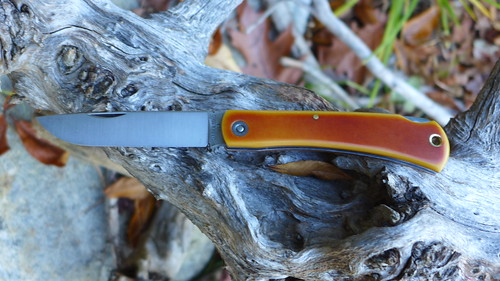
You can find the Mudbug here. There are no other reviews. The knife is $80. I have already given this knife away. There are three versions, a maroon micarta, a green micarta, and this version, the natural paper micarta.
The Mudbug is a small batch production knife designed (or tweaked) by Smith and Sons, a custom fixed blade outfit out of Louisiana, and produced by Great Eastern Cutlery. It is a modification of the GEC #21 Bull Buster. The Bull Buster is not a small blade, but the Mudbug ratchets up the build by adding a lockback, using a bird's eye pivot, and adding steel liners. This is what a hard use traditional knife looks like. The Mudbug runs 1095 steel.
One thing that is hard to appreciate in pictures is just how big this knife is. It is MASSIVE. Remember when you went back to the Buck 110 for the first time after handling Delicas and Mini Grips? Remember how you thought it was SO BIG. You will have the same experience here.
Overall the design is excellent--thin, easy to carry, without snag points or sharp edges. There is no clip, and I wish there was, but this is a traditional knife. Smith and Sons offers a clever belt sheath to go with the knife and if you plan on carrying this blade into the woods I would recommend getting the sheath. Its smooth micarta handles make this knife a slippery booger. The fit and finish is outstanding, as is to be expected from GEC. The blade shape is superb as well--a sodbuster type blade with a good point, ample belly, and a long straightaway.
I do have to take off points for the steel. 1095 is a venerable steel and in big fixed blades it works well. As implemented here--on a thin traditional folder, it leaves something to be desired. The problem is that this knife keeps the blade thin, much thinner than modern folders, but it bills itself as a hard use knife. Given that sort of cross purposing, I just don't like the 1095. If you are making a small swayback or Texas Toothpick, the slim slice of 1095 is fine. But if you bill your knife as a hard use blade, either make the blade of 1095 thick or use a different steel. As it is, I had to sharpen the knife quite a bit and one microscopic chip developed in the edge during only moderately hard use (delimbing a small tree). Not a big deal, but something that could be easily avoided.
Overall Score: 16 out of 20 (2 off for the steel choice and 2 off for the lack of a clip when the handles are this smooth).
Condor Bushlore
Condor tools are pretty well known, especially in outdoors/bushcraft circles. They offer a low-mid range between Moras and the more expensive stuff like the bigger Ka-Bars and ESEE steel. They are made in El Salvador and most are based on traditional or even indigenous blade shapes. The Bushlore isn't a traditional blade shape, but it is a very important design. It takes its blade, handle, and size from the ideal outdoor knife as described by Mor Kochanski in his book Bushcraft.
Here is the passage for Bushcraft:
Muyshondt Mako Mk. II
The original Mako was designed as a great, keychain light, a reflectorless torch with long runtimes, simple, failproof UI, and a very compact design. The Mako II, offered in a regular and high performance option (which doubles the lumens output on high to 60), improves on the output and runtime of the original.
Smith and Sons Mudbug

You can find the Mudbug here. There are no other reviews. The knife is $80. I have already given this knife away. There are three versions, a maroon micarta, a green micarta, and this version, the natural paper micarta.
The Mudbug is a small batch production knife designed (or tweaked) by Smith and Sons, a custom fixed blade outfit out of Louisiana, and produced by Great Eastern Cutlery. It is a modification of the GEC #21 Bull Buster. The Bull Buster is not a small blade, but the Mudbug ratchets up the build by adding a lockback, using a bird's eye pivot, and adding steel liners. This is what a hard use traditional knife looks like. The Mudbug runs 1095 steel.
One thing that is hard to appreciate in pictures is just how big this knife is. It is MASSIVE. Remember when you went back to the Buck 110 for the first time after handling Delicas and Mini Grips? Remember how you thought it was SO BIG. You will have the same experience here.
Overall the design is excellent--thin, easy to carry, without snag points or sharp edges. There is no clip, and I wish there was, but this is a traditional knife. Smith and Sons offers a clever belt sheath to go with the knife and if you plan on carrying this blade into the woods I would recommend getting the sheath. Its smooth micarta handles make this knife a slippery booger. The fit and finish is outstanding, as is to be expected from GEC. The blade shape is superb as well--a sodbuster type blade with a good point, ample belly, and a long straightaway.
I do have to take off points for the steel. 1095 is a venerable steel and in big fixed blades it works well. As implemented here--on a thin traditional folder, it leaves something to be desired. The problem is that this knife keeps the blade thin, much thinner than modern folders, but it bills itself as a hard use knife. Given that sort of cross purposing, I just don't like the 1095. If you are making a small swayback or Texas Toothpick, the slim slice of 1095 is fine. But if you bill your knife as a hard use blade, either make the blade of 1095 thick or use a different steel. As it is, I had to sharpen the knife quite a bit and one microscopic chip developed in the edge during only moderately hard use (delimbing a small tree). Not a big deal, but something that could be easily avoided.
Overall Score: 16 out of 20 (2 off for the steel choice and 2 off for the lack of a clip when the handles are this smooth).
Condor Bushlore
Condor tools are pretty well known, especially in outdoors/bushcraft circles. They offer a low-mid range between Moras and the more expensive stuff like the bigger Ka-Bars and ESEE steel. They are made in El Salvador and most are based on traditional or even indigenous blade shapes. The Bushlore isn't a traditional blade shape, but it is a very important design. It takes its blade, handle, and size from the ideal outdoor knife as described by Mor Kochanski in his book Bushcraft.
Here is the passage for Bushcraft:
The general purpose bush knife should have a blade as long as the width of the palm...[a]ll general use knives should have the blade tip close to the profile center line of the handle. The back of the handle and the back of the blade should be on the same line...The blade should be of a good quality carbon steel, from two and half to three millimeters thick and about two and half centimeters wide...The metal of the knife should extend the full length of the handle (a full tang) for strength....The curvature of the cutting edge should extend for the full length of the blade...(Bushcraft, pgs. 109-111).
Here is the product page. This is a sub-$40 knife. There is a micarta handle version that is more expensive. Here is a review. And here is the Bushlore (to be given away):
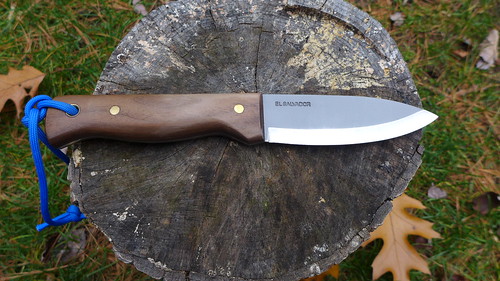
Here is a link to purchase the Bushlore, with proceeds benefiting the site:
It is the exact knife Mors describes in every way. And in that sense, the design is both excellent and timeless. But the materials are greatly under par, even at the $40 price point. You can score a Boker or Kershaw fixed blade with better steel (440c or 14C28N) for the same price. The 1075 steel is very tough, but very soft and prone to staining. Its not bad in this role, but after using other steels, you get spoiled. The handles are extremely comfortable in the hand--no hotspots or awkward hand holds here. This handle is almost as good as the Becker handle, but loses a bit of security in high powered cuts due to the lack of an extreme parrot beak. The walnut on the handle is smooth but cheap. A little sweat from the hand took off the color and made my hand a tad brown. The knife is quite durable, with a full tang. It took quite beating and the edge wasn't impossible to restore. I can't avoid the point--this is a cheap knife because the materials are cheap--soft steel and less than okay handle scales.
While the knife is only okay, the sheath is amazing for the money:
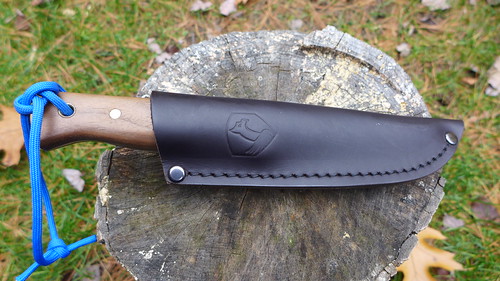
The leather is thick, the belt loop is nice, the stitching is clean and even. The knife is quite secure in the sheath too, maybe a little too secure.
Overall Score: 13 out of 20 (2 off for fit and finish with a rough grind on the steel and poorly finished and stained handles; 2 off for steel; 1 off for sheath accessibility as this is an all-hands on deck sheath design; and 1 off for durability as the wood handles looked and felt pretty bad after moderate to heavy use over a period of a few weekends)
Bellroy Elements Pocket Wallet
Here is the product page. This is a sub-$40 knife. There is a micarta handle version that is more expensive. Here is a review. And here is the Bushlore (to be given away):

Here is a link to purchase the Bushlore, with proceeds benefiting the site:
It is the exact knife Mors describes in every way. And in that sense, the design is both excellent and timeless. But the materials are greatly under par, even at the $40 price point. You can score a Boker or Kershaw fixed blade with better steel (440c or 14C28N) for the same price. The 1075 steel is very tough, but very soft and prone to staining. Its not bad in this role, but after using other steels, you get spoiled. The handles are extremely comfortable in the hand--no hotspots or awkward hand holds here. This handle is almost as good as the Becker handle, but loses a bit of security in high powered cuts due to the lack of an extreme parrot beak. The walnut on the handle is smooth but cheap. A little sweat from the hand took off the color and made my hand a tad brown. The knife is quite durable, with a full tang. It took quite beating and the edge wasn't impossible to restore. I can't avoid the point--this is a cheap knife because the materials are cheap--soft steel and less than okay handle scales.
While the knife is only okay, the sheath is amazing for the money:

The leather is thick, the belt loop is nice, the stitching is clean and even. The knife is quite secure in the sheath too, maybe a little too secure.
Overall Score: 13 out of 20 (2 off for fit and finish with a rough grind on the steel and poorly finished and stained handles; 2 off for steel; 1 off for sheath accessibility as this is an all-hands on deck sheath design; and 1 off for durability as the wood handles looked and felt pretty bad after moderate to heavy use over a period of a few weekends)
Bellroy Elements Pocket Wallet
I tested this thing not once, not twice, but three different times with breaks in the middle to make sure I got it right. I did. This stinks. Here is the product page. This is a $140 wallet. Here is a review of its bigger brother, the Elements Travel Wallet. This was sent to me by Bellroy and is in the giveaway pile for the next WWP benefit.
Bellroy's wallets have been, thus far, amazingly good. But this number has been, each time, a complete and total hassle to use.
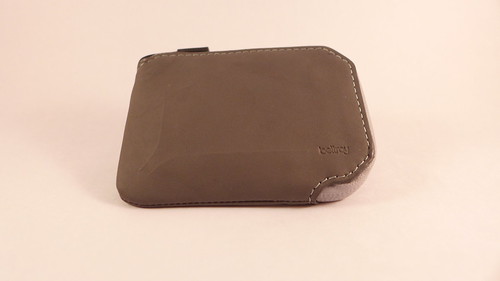
Bellroy's wallets have been, thus far, amazingly good. But this number has been, each time, a complete and total hassle to use.

The leather is great and the zipper is nice. The stitching is customary Bellroy--that is to say, very good. The overall size is a bulkier than I like, coming in at probably twice as thick as a similarly loaded Note Sleeve. I guess that is to be expected given the design is a rugged wallet. There is not a whole lot of bad stuff with how the wallet is made.
The problem is simple--this wallet is nigh impossible to open and access stuff. Forget about slipping something out during a hike or a train ride one handed. This isn't even a two handed wallet. Really you need three hands, one to hold the wallet and two others to pry it open. The zipper path needs to be about a half inch longer and then you could really open the wallet up. As it is, even with a minimal card complement and a smidgen of cash, this thing just doesn't allow ready and easy to anything inside.
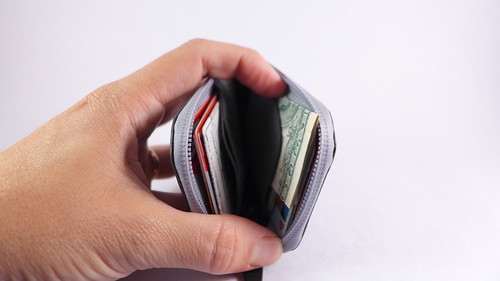
For a wallet, a product designed to hold things for ready access, that is a failure.

For a wallet, a product designed to hold things for ready access, that is a failure.
Maybe other wallets in this series work better, but this one is awful.
Overall Score: 10 out of 20 (2 off for design; 2 off for carry as this is a bulky, wad in your pocket; 2 off for accessibility; 2 off for its distinctively non-serious appearance; and 2 off for efficiency as this is a fat sucker, given what it can carry)
Muyshondt Mako Mk. II
Its no surprise that I like this light. Enrique's work, for me, is among the best gear out there. It is all smartly designed, beautifully made, and relentlessly purpose driven. There is no bullshit, no extra "features" that make the light hard to use, and nothing to waste precious battery life. Enrique's lights are among the best in the business and the Mako Mk. II is no different.
Here is the Mako product page. This is a $199 light in the high output mode, which I reviewed. There are no other reviews. Here is the review sample (already returned to Enrique):
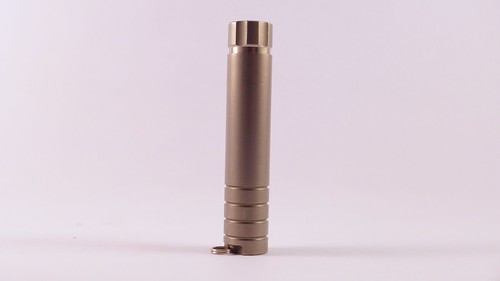
Here is the Mako product page. This is a $199 light in the high output mode, which I reviewed. There are no other reviews. Here is the review sample (already returned to Enrique):

The original Mako was designed as a great, keychain light, a reflectorless torch with long runtimes, simple, failproof UI, and a very compact design. The Mako II, offered in a regular and high performance option (which doubles the lumens output on high to 60), improves on the output and runtime of the original.
In carrying the Mako for a month or so I was really impressed at how practical it was. This is probably not a light that would be a great solo EDC torch. The 21 lumen high is useful, but probably not enough. If you are looking for a light like that, the Aeon Mk. II works well. Instead the Mako II is the perfect, and I mean perfect, keychain light. The size is perfect:
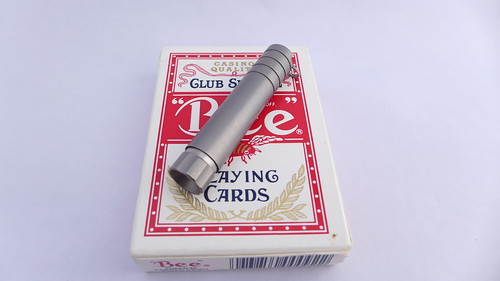
As something you want to use to find dropped pen or illuminate a doorknob, the Mako II can't be beat. The key, aside from the small form factor, is the runtime. Enrique's magic has always been runtime performance and the Mako is no exception. Running on a single AAA, the runtimes seem to be around 60 hours on low using a regular alkaline battery--an impressive showing.

As something you want to use to find dropped pen or illuminate a doorknob, the Mako II can't be beat. The key, aside from the small form factor, is the runtime. Enrique's magic has always been runtime performance and the Mako is no exception. Running on a single AAA, the runtimes seem to be around 60 hours on low using a regular alkaline battery--an impressive showing.
If you are looking for the spiritual successor to the Arc AAA-P, with "modern" conveniences like multimode output, the Mako II is it. At $200 its not cheap, but when you amortize that over the life of the light it is actually quite affordable.
Overall Score: 19 out of 20 (1 point off for a low high, even for a keychain light)
